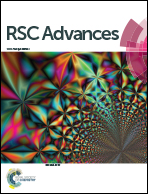Physical and biological activities of newly designed, macro-pore-structure-controlled 3D fibrous poly(ε-caprolactone)/hydroxyapatite composite scaffolds
Abstract
Electrospun poly(ε-caprolactone) micro/nanofibers have been used widely for tissue regeneration. However, their low three-dimensional (3D) shape-ability, difficult macro-pore-structure controllability, and relatively low bioactivities have been major obstacles to their use as various tissue regenerative scaffolds. In this study, we present a new 3D fibrous scaffold in which the macrosized pore structure was manipulated using an electrohydrodynamic jet process supplemented with in vitro mineralization to obtain a hydroxyapatite (HA) layer in simulated body fluid (SBF). The fabricated scaffolds were a mesh-like structure (average diameter of fiber bundles: 342 ± 36 μm; average diameter of microfiber: 8.5 ± 1.2 μm) with high porosity (>91%), macro-pore size (368 ± 16 μm), and 100% interconnected pores. The HA particles on the surface of the scaffolds were well developed after a 7 day incubation in SBF, and the 3D fibrous scaffolds showed markedly higher and more homogenous HA deposition compared with that of control scaffolds fabricated with solid free-form fabrication, due to the larger surface area of the fibrous bundles. The mineralized scaffolds were analyzed in terms of various physical and biological properties (water and protein absorption, mechanical properties, cell viability, DAPI/phalloidin staining, and osteogenic gene expression). Protein and water absorption of the fibrous scaffolds at 12 h were ∼2.5-fold and ∼2.3-fold greater than those of the control scaffolds. Additionally, proliferation of viable cells (MC3T3-E1 pre-osteoblasts) on the 3D fibrous scaffold improved significantly compared to the control. The osteogenic gene expression (alkaline phosphatase activity and calcium mineralization) levels of the fibrous scaffolds were significantly enhanced compared with those of the control scaffolds.


 Please wait while we load your content...
Please wait while we load your content...